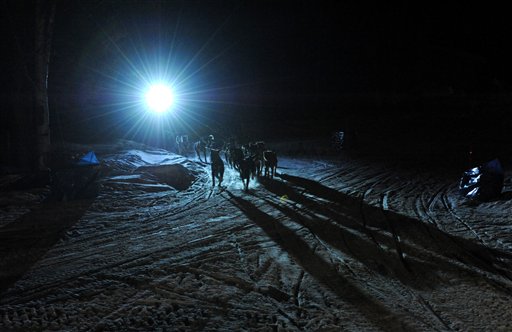ANCHORAGE, Alaska - There comes a time during the Iditarod Trail Sled Dog Race when fatigue can turn Alaska's frozen landscape into an unlikely habitat for an elephant that really isn't there.
Ask Lynda Plettner, a former participant in the 1,000-mile race. The Big Lake, Alaska, musher was so sleep-deprived once that she saw a large gray African elephant in the distance trudging in the snow toward a metal building that had no doors or windows. Both the elephant and the building got bigger as Plettner got closer and her weary brain focused on getting the dogs safely past them before it dawned on her that she was hallucinating.
"I concluded that that couldn't possibly be there," she said.
Participants in this year's race are struggling with their own exhaustion in their journey toward the finish line in Nome on Alaska's western coast. But they keep on mushing anyway.
Four-time Iditarod champion Martin Buser, of Big Lake, reclaimed the lead Friday afternoon that was taken earlier by Aliy Zirkle, last year's runner-up. Zirkle, of Two Rivers, had been the first to reach the village of Grayling, a checkpoint on the Yukon River, which is the trail for 238 miles of the race, but Buser caught up and left before Zirkle.
Buser was first into the previous checkpoint at Anvik early Friday. But he decided to take a mandatory eight-hour break there, while Zirkle blew out of the village one minute after arriving. Zirkle arrived at Grayling 18 miles away almost three hours before Buser, but he caught up and left the village after only 10 minutes.
Teams must take the eight-hour layover at one checkpoint on the frozen Yukon River. Mushers also may take the layover at Shageluk - 25 miles east of the river - during odd numbered years when the village is included in a part of the race that takes a southern route. Mushers also are required to take another eight-hour rest at the White Mountain checkpoint 77 miles from the finish line in Nome.
Break or no break, mushers get only a fraction of the rest that their hard-running dogs do, many said before the race began last weekend. The human participants take care of their dogs first when they stop, serving up hearty stews for their teams. Dogs nap while the mushers melt snow to fix food for their teams, massage dog paws and shoulders, fill up on their own grub, fix damaged sleds and study the strategy of rivals.
"They know what they're supposed to do, and they absolutely know what I'm supposed to give them," Zirkle said of her team. "And if I don't, that relationship is broken and we can't do the race. So it's really on me, honestly."
Four-time champion Lance Mackey had been leading earlier this week when he was the first to reach the halfway checkpoint at the ghost town of Iditarod. Mackey, who was in 10th place Friday afternoon, said at that time, he had taken no shut-eye since a short nap at an earlier checkpoint. So he was feeling out of sorts and wasn't sure if a light he saw along the trail since then was real, the Fairbanks musher told Iditarod greeters as he arrived there Wednesday evening.
"It looked like a light beacon up in the air," Mackey said in an Iditarod.com video. "I don't know what it was. It probably wasn't even there. But I saw it."
Mushers catch what little sleep they can, when they can. But many will shrug and tell you it's no big deal. It's just part of running an endurance match in some of the world's toughest conditions, where blizzards can create blinding stretches of trail, temperatures can plunge to 50 below - or, as is happening in this race, above-freezing temperatures can slow teams down in punchy snow or river overflows.
Buser, for one, crossed a wet creek barefooted Thursday after shedding his clothes in case he fell in, according to an Iditarod representative.
The race is a grueling run that mushers and their teams train hard for. So they are conditioned for it, to a certain degree. But that doesn't make it pain-free.
Defending champion Dallas Seavey, of Willow, said his dogs get up to 10 hours of sleep a day during the race while he is lucky to get 75 minutes. And if a dog needs some extra rest, Seavey will carry it in the sled for stretches of the trail.
Seavey, in 18th place Friday, said mushers can become "pretty much destroyed" by sleep deprivation by the time they reach Unalakleet, where the coastal run portion starts along the wind-battered Bering Sea coast.
This is when mushers are so foggy with fatigue that they can focus on one lagging dog, instead of all the strong ones, rather than leave the weaker dog behind, Seavey said. Mushers can become overwhelmed by pessimism where all they see are problems and defeat. They can oversleep, as Seavey has in past races.
"I see mushers lose the race right there by making poor decisions," he said. "Your decision-making ability is pretty slim to nil at this point."

